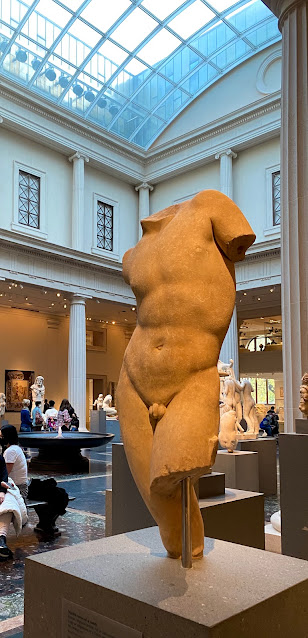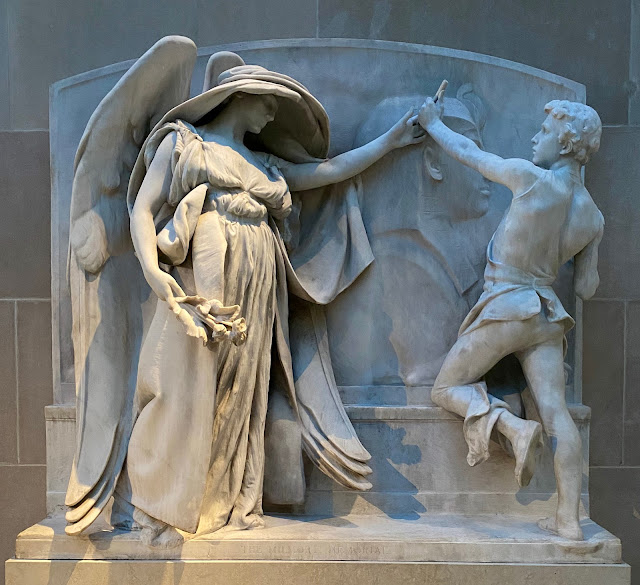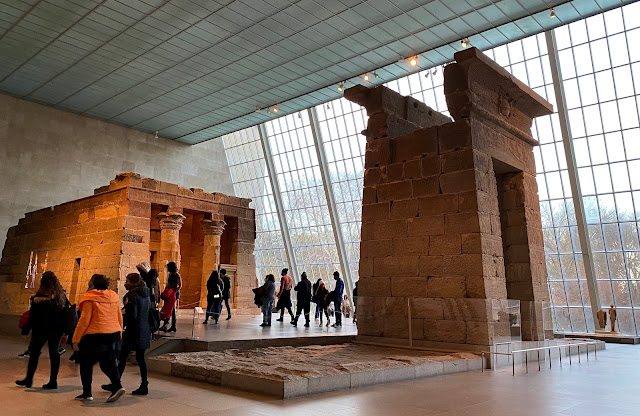After leaving The Cloisters I made my way to The Metropolitan Museum of Art. I had enough time between museums to pop into The New Amity Restaurant for a quick bite to eat.
 |
| Head of a goddess. Greek, 2nd-1st century B.C. |
 |
| Marble statue of a girl. Roman, 1st or 2nd century A.D. |
 |
| Marble torso of a youth. Roman, 1st or 2nd century A.D. |
 |
| Wall painting (Return of a mounted warrior). Greek, mid 4th century B.C. |
 |
| The Three Graces. Roman copy of a Greek work of the 2nd century B.C. |
 |
| Detail of The Three Graces. |
 |
| Detail of Bronze statue of Artemis and a deer. Greek or Roman, 1st century B.C. to 1st century A.D. |
 |
| Marble statue of a bearded Hercules. Roman, 68-98 A.D. (With restorations made during the early 17th century). |
 |
| Terracotta plaque. Roman, 27 B.C. - 68 A.D. |
Pelops won the hand of Hippodamaia after defeating her father, King Oinomaos, in a chariot race by bribing the kings charioteer.
 |
| Terracotta plaque. Roman, 27 B.C. - 68 A.D. |
King Oinomaos mounts the chariot driven by Myrilos, the charioteer who accepted the bribe from Pelops.
 |
| Marble head of a goddess. Roman, 1st century A.D. |
 |
| Alabaster cinerary urn. Roman, 1st century A.D. |
 |
| Cubiculum (bedroom) from the Villa of P. Fannius Synistor at Boscoreale. Roman, 50-40 B.C. |
This room was buried in the eruption of Mount Vesuvius in 79 A.D.
 |
| Detail of the Cubiculum wall painting. |
 |
| Gold and rock crystal ring with box-shaped bezel. Greek, 2nd century B.C. |
This ring was such a breathtaking work of art. Every bit was crafted to perfection. The twisted band with garnets on the sides and bottom, the delicate gold filigree on the bezel. But the most astonishing part of all was that underneath the rock crystal there is a miniature scene of a tiny golden bird sucking nectar from a flower in a garden. Just brilliant in its imagination and craftsmanship.
 |
| Two gold necklaces. Greek, 4th - early 3rd century B.C. |
 |
| Marble relief with a dancing maenad. Roman, 27 B.C. - 14 A.D. (Copy of a Greek relief, 425 - 400 B.C.) |
The description indicated: “Maenads were mythical women inspired by the god of wine, Dionysos, to abandon their homes and families and roam the mountains and forests, singing and dancing in a state of ecstatic frenzy. This figure, wearing an ivy wreath and carrying a thyrsos (fennel stalk) bedecked with ivy leaves and berries, moves forward trancelike, her drapery swirling about her”.
 |
| Marble grave stele of a little girl. Greek, 450-440 B.C. |
This was one of the pieces I remembered seeing from my trip back in 2007. A loving and expressive tribute for a young girl and her affection for her pet doves.
 |
| Marble grave stele with a family group. Greek, 360 B.C. |
The description indicated: “Because the framing niche that once surrounded their relief is missing, there are no inscriptions that might identify the deceased. Both the seated man and the veiled woman behind him stare straight ahead, as if the young woman who gazed down at them is invisible. Do they mourn their dead daughter? Does she mourn her dead father or is she the sole survivor of the group? Despite its ambiguity and solemn sadness, the relief conveys an intense, though restrained, sense of family unity”.
 |
| Detail of Bronze pointed neck-amphora with stand. Greek, 500-450 B.C. |
 |
| Akhtihotep Reliefs. Saqqara, 2575-2551 B.C. |
 |
| Ship under Sail. Saqqara, 2465-2458 B.C. |
 |
| Deity Procession with Winged Sun Disk. Egypt, 1961-1917 B.C. |
 |
| Cartouches of Senwosret I. Egypt 1961-1971 B.C. |
 |
| Flying Horus with Shen Sign (left) and Ritual Scene with Senwosret I (right). Egypt, 1961-1917 B.C. |
 |
| Two Mirrors, Drinking Vessels, and Cosmetic Jars. Thebes, 1479-1425 B.C. |
 |
| Mechanical Dog. Egypt, 1390-1353 B.C. |
Another remarkable piece I remembered from my visit in 2007. This dynamic little dog has a lever on its chest that can open and close its mouth. Two teeth and a red tongue are visible when the mouth is open.
 |
| Temple of Dendur. Roman Period, completed by 10 B.C. |
A projection on the side of the Temple of Dendur, showing how the original colors may have looked.
 |
| America by Hiram Powers. 1850-1854. |
The Charles Engelhard Court.
 |
| The Angel of Death and the Sculptor from the Milmore Memorial by Daniel Chester French. 1921-1926. |
 |
| Mourning Victory from the Melvin Memorial by Daniel Chester French. 1912-1915. |
 |
| Autumn Landscape. Design attributed to Agnes Northrop for Tiffany Studios. 1923-1924 |
The description indicated: “No paint was used to add detail; rather, the modeling, texture, and form were created solely with glass, using the full range developed at Tiffany Studios. The variegated surface was made by wrinkling glass in its molten state. Different color effects were achieved by embedding tiny, confetti-like flakes of glass in the surface”.
 |
| Detail of Armor with Matching Shaffron (Horse’s Head Defense). Italian, 1600. |
 |
| Shaffron. Italian, 1600. |
 |
| Detail of Armor of Henry II of France. French, 1555. |
 |
| Fencing Doublet. Western European, about 1580. The rapiers in the background are mostly of Italian and German origin from the 1600’s. |
 |
| A collection of smallswords from Europe and Russia from the 1700’s. |
 |
| Armor Garniture of George Clifford, Third Earl of Cumberland. English, 1586. |
George Clifford was a favorite of Queen Elizabeth I and his set of armor is the best preserved from the royal workshops at Greenwich.
 |
| Field Armor of King Henry VIII of England. Italian, 1544. |
This armor was made towards the end of Henry’s life when he was overweight and suffering from gout. In spite of his physical limitations the armor was probably worn during the siege of Boulogne, which he personally commanded.
 |
| Dagger (Katar). Indian, 18th century. |
These daggers (katars) were meant to be held by the cross bars in a clenched fist. This blade has a medallion at the top with an inscription that reads: “Help from Allah and a speedy victory. So give the glad tidings to the believers”.
 |
| Detail of a Saber. Turkish, 1522-1526. |
 |
| Detail of a Saber with Scabbard. Turkish, 19th century. |
The ceremonial saber was most likely assembled by a court jeweler and the emerald on the far left opens to reveal a secret compartment with a gold coin. The coin is marked with the name of Süleyman the Magnificent, the most powerful Ottoman ruler of the 16th century. The underside of the emerald is inscribed with the phrase “According to God’s will”.
 |
| Eternal Spring by Auguste Rodin. French, 1907. |
 |
| Detail of Pygmalion and Galatea by Auguste Rodin. French, 1908-1909. |
The description indicated: “According to classical mythology, the sculptor Pygmalion so desired a marble woman he had carved that Venus, the goddess of love, granted her life. Rodin depicts the statue of Galatea quickening at the sculptors touch, her glowing body emerging from unfinished stone. Yet this Pygmalion is not the handsome youth of tradition, but rather a stocky, bearded man resembling Rodin, whose name is prominently inscribed next to the mythical sculptor’s on the side of the base. In his quest to endow his figures with living force, Rodin regarded himself as a modern Pygmalion”.
 |
| The Birth of Venus by Alexandre Cabanel. French, 1875. |
 |
| Assyrian palace sculptures, 883-859 B.C. |
This exhibit had been set up to recreate the reception room in the palace of King Ashurnasirpal II at Kalhu (modern Nimrud in northern Iraq). The reliefs that lined the walls had come from various rooms within the palace.
 |
| Assyrian palace sculptures, 883-859 B.C. |
The description indicated: “the text carved across the panels is today called the Standard Inscription, because it was repeated across most of the reliefs in the palace. It lists Ashurnasirpal’s titles, ancestry and achievements, including the building of the palace itself. It is written from left to right in the Assyrian dialect of Akkadian, a Semitic language. The wedge-shaped script is known as cuneiform, after the Latin cuneus (wedge)”.
 |
| Assyrian palace sculptures, 883-859 B.C. |
 |
| Assyrian palace sculptures, 883-859 B.C. |
 |
| Assyrian palace sculptures, 883-859 B.C. |
Figures with wings and eagle heads are considered magical, protective beings. Some may represent legendary sages from the distant past called apkallu.
 |
| Assyrian palace sculptures, 883-859 B.C. |
The description indicated: “Important gateways in Assyrian palaces we’re guarded by colossal statues with human heads, wings of great birds, and the bodies of bulls or lions. The statues provided magical protection from demonic forces and confronted visitors as they approached. The figures have five legs each, so that they appear to be standing guard from the front yet active and striding forward in profile. Originally each gate featured a matching pair of two bulls or two lions. The gateway in this gallery has one bull and one lion, from different gates in the same courtyard”.
 |
| Bricks with a palmette motif. Iran, 5th-4th century B.C. |
 |
| Rhyton terminating in the forepart of a wild goat. Iran, 4th-2nd century B.C. |
 |
| Figure of a reclining woman. Mesopotamia, 2nd century B.C. - 2nd century A.D. |
 |
| Panel fragment with the god Shiva/Oesho. Bactria, 3rd century A.D. |
 |
| Young Lovers Embracing. Iran, 16th century. |
 |
| Drawing of an Angel. Iran, 16th century. |
 |
| Zal Consults the Magi. Attributed to Sultan Muhammad, assisted by ‘Abd al-‘Aziz. Iran, early 16th century. |
The description indicated: “In this painting, Zal is depicted enthroned as he consults his magi, or Zoroastrian wise men, on how to win his father’s approval to marry Rudaba, the granddaughter of the evil King Zahhak. The phoenix-like bird on the canopy may refer to the simurgh, which saved and nurtured the infant Zal, whose parents had rejected him for being an albino.”
 |
| Velvet Panel with Hunting Scene. Iran, 1540. |
 |
| The “Seley” Carpet. Iran, late 16th century. |
This massive and beautifully intricate carpet is one of the finest Persian carpets known. It was produced at a time when the art of carpet weaving had achieved its greatest heights under the patronage of the Safavid shahs.
 |
| Rustam Avenges His Own Impending Death. Attributed to Bashdan Qara. Iran, 1525-1530. |
The description indicated: “Rustam’s wicked half-brother Shaghad conceived a plan to kill him by preparing a hunting ground with pits filled with upright spears. When Rustam went hunting near these traps, he fell into a pit and was impaled. Realizing that Shaghad, watching from behind a tree, had devised the plot, Rustam sent an arrow through the tree and killed Shaghad, shortly before he himself died.”
 |
| Qur’an Bookbinding inset with Turquoise. Iran, 16th century. |
 |
Brooch with Carved Emeralds and Sapphires by Cartier. (Central emerald was carved between 1660-1700, mounted by Cartier in 1920.) |
The description indicated: “In the early twentieth century, several Indian princes commissioned Jacques Cartier to redesign their antique jewelry to reflect modern designs. This patronage, coupled with Cartier’s trips to India and his collection of historical jewels, inspired him to incorporate Indian styles into his own work and reset gems into modern settings. This brooch is one such example: the central emerald is carved with a Mughal floral design and was mounted by the designer onto a jeweled platinum border”.
 |
| Hawk Coin of the Emperor Akbar, Portrait Coin of the Emperor Jahangir, and Group of Zodiac Coins (Capricorn, Pisces, Taurus, Leo, and Aries). India, 1556-1618. |
 |
| Rustam Captures Rakhsh. India, mid 15th century. |
When Rustam came of age his father Zal promised him that he could choose a wild horse. Rustam picked a horse that was notoriously difficult to catch and had evaded capture for three years. However, Rustam was successfully able to capture and ride the horse.
 |
| Detail of Portrait of Mulla Muhammad Khan Vali of Bijapur painted by Hashim. India, 1620. |
 |
| Spotted Forktail painted by Abu’l Hasan. India, 1610-1615. |
 |
| Fairies Descend to the Chamber of Prince Manohar. India, 1700. |
The Gulshan-i ‘Ishq (Rose Garden of Love) tells the complicated tale of several pairs of lovers. In this scene, fairies have descended to the bedchamber of Prince Manohar. They have decided to transport him to his beloved Princess Madhumalati, for whom he pines.
After the museum I met my mother and brother in Little Italy for a lovely pasta dinner at La Bella Vita.
An apartment glowing with Christmas lights.














































































































